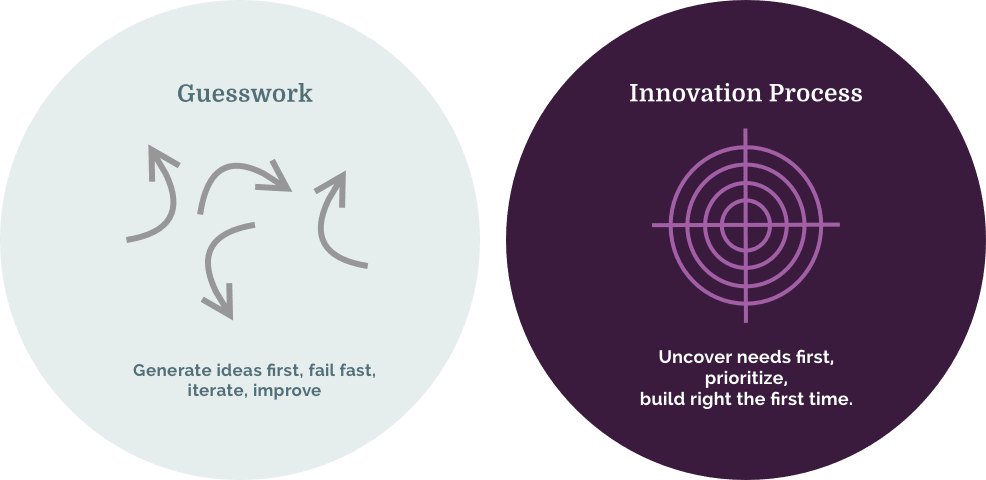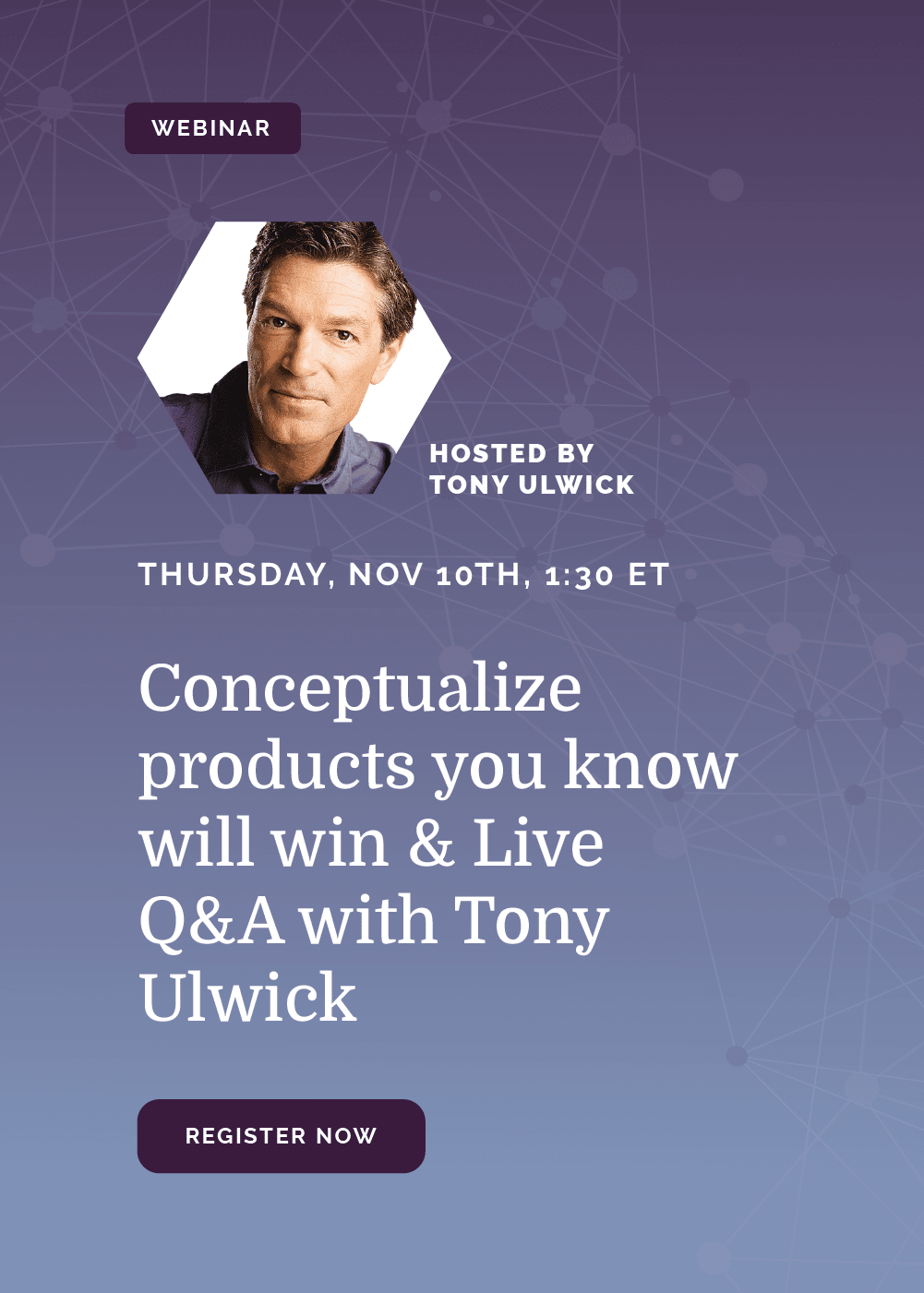Innovation is a process. It is defined as the process of devising a solution that addresses unmet customer needs.
A great innovation process enables innovators to conceptualize products and services that they know, with a high degree of confidence, will win the marketplace—BEFORE development even begins.

The process starts with a deep understanding of the job the customer is trying to get done and the metrics they use to evaluate competing product and service offerings.
By knowing how customers measure value, companies are able to align the actions of marketing, development, and R&D with these metrics and systematically create customer value.
With new product failure rates around 80%, chances are your innovation process lets you down more often than not. Discover how the Innovation process takes the guesswork out of innovation and significantly improves your chances of success.
Over the years, managers have been conditioned to believe that innovation is an inherently random process; that the acceptance of failure must be baked into company culture; and that pivoting and failing fast is the way to make the innovation process more efficient.
We’ve proven that these beliefs are based on a misunderstanding of innovation as a process. The truth is the process of innovation can be executed in a way that delivers predictable, breakthrough results.
Innovation is a top priority for nearly every company and yet, new product success rates are still abysmal.
Product teams struggle because:
An effective innovation process must overcome all these obstacles. A company must know all the customer’s needs and determine which are unmet before idea generation begins and ideas are collected and evaluated.
People buy products and services to get a job done. Defining your market around this job-to-be-done gives your company a stable focal point around which to align and orchestrate value creation.
This step includes:
Customers want to get their jobs done perfectly. The 100+ metrics customers use to measure the successful execution of a job-to-be-done define what perfection means—and instruct your company how to deliver it.
This innovation process step includes:
Customers have underserved and overserved needs. Knowing with statistical certainty which needs should be the focus of your value creation and cost reduction ensures the efficient deployment of resources.
This step includes:
Customers rarely agree on which needs are unmet. Segmenting your markets into groups of people with unique sets of unmet needs allows you to pursue opportunities your competitors will fail to see.
This process step includes:
With a common understanding of the customer’s unmet needs, your company is able to better position and improve existing products, identify and fill gaps in your portfolio, make impactful R&D investment decisions, and more.
In other words, you have everything you need to develop a reliable innovation strategy.
The goal of the ideation process should not be lots of ideas and idea generation activities. Instead, the goal should be to construct the single, best solution to satisfy the unmet customer needs of the target customers and segments, enabling them to get the job done faster, more conveniently, and more effectively than ever before.
There is one belief that permeates academic literature and has influenced nearly all gated product development processes: it is the notion that the innovation process begins with an idea. This is the myth that misleads. An idea is the output of the innovation process, not the starting point. Making ideation and idea management the starting point of the innovation process, although common, turns innovation into a guessing game. It is the most inefficient approach to innovation and the root cause of low innovation success rates.
Competitive analysis, when seen through a jobs-to-be-done lens, is not about head-to-head comparisons. Instead, it’s about assessing how much better or worse a product is at helping the customer get a job done.
Traditional competitive analysis almost always involves a technical comparison of product specifications and features, yet the analysis is conducted without knowing how customers measure value or how much value competing features deliver to the customer. This is the problem, and the myth that misleads: companies are not competing against other companies or their products. They are competing for the customers, and their one goal is to create value for them. And there is only one way to do that: by offering a product or service that is better than any other at helping them get their jobs done.
Through a jobs-to-be-done lens, the goal of the concept testing process is to validate that a product concept is better than competing solutions at helping customers get a job done. To make this determination, we must know what metrics the customers use to measure the successful execution of the job-to-be-done. Our methods work because they are built around these customer metrics.
The goal of product positioning is to present a product or service to the customer in a way that effectively communicates its value. When looking at the product positioning process through a jobs-to-be-done lens, we see that the best way to communicate value to customers is to explain (1) how the product helps them execute the functional job better than competing solutions and (2) how it satisfies the emotional jobs that are associated with getting the functional job done.
The size of a market can be calculated based on the number of potential job executors, the frequency with which they execute the job, and their willingness to pay to get the job done better. An attractive market consists of a large number of underserved executors who have a high willingness to pay to get the job done better. This forms an effective market sizing calculation.
Companies often size the market they are interested in by determining the dollar volume of the products being sold. Using that calculation, they decide to invest or divest in a market based on trends in revenue growth.
But here is the problem, and the myth. A product is not a market. Every product will one day become a thing of the past. Vinyl records and cassettes gave way to CDs and MP3s, but in time those formats too will fade. But just because a technology or a product becomes obsolete doesn’t mean the market disappeared. It means that the market (the people who hired the product to get a job done) moved on to buy another product; one that helped them get the job done better.
According to Tony Ulwick’s Outcome-Driven Innovation (ODI) framework, the innovation process begins with a deep understanding of the job-to-be-done. This approach emphasizes starting with a clear and precise definition of what customers are trying to achieve. The first step is to identify the customer and the job they are trying to get done. This involves gathering and analyzing customer needs and desired outcomes using unique quantitative research methods. By focusing on the job-to-be-done, companies can align their innovation efforts with customer-defined performance metrics, leading to more predictable and successful outcomes.
The last step of the innovation process is formulating the product strategy. This step involves creating a comprehensive plan that outlines how a company will develop and deliver new products or services that align with the identified customer needs and market opportunities. The product strategy ensures that the innovation efforts are effectively translated into actionable steps for product development, addressing the most critical and underserved customer outcomes.
Key activities in this final step include:
By the end of this step, companies should have a clear, actionable plan that guides the development and launch of new offerings, optimized to meet customer needs and achieve competitive advantage.
According to Tony Ulwick’s book “Jobs to be Done: From Theory to Practice,” there are several common challenges and recommended strategies to overcome them:
Understanding and Prioritizing Customer Needs:
Building Internal Competency in ODI:
Overcoming Resistance to Change:
Companies can successfully implement the ODI process and drive innovation closely aligned with customer needs by addressing these challenges with structured frameworks, dedicated training, and stakeholder engagement.
If you’re ready to launch the next big thing, it’s time to upgrade to Outcome-Driven Innovation. Get in touch to speak with one of our innovation experts.

Copyright ©2024 Strategyn LLC. All Rights Reserved. | XML Sitemap | HTML Sitemap